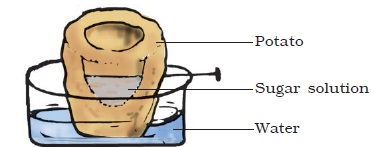Candidates can download NCERT Exemplar Class 7 Science Unit 11 from this page. The exemplar has been provided by the National Council of Educational Research & Training (NCERT) and the candidates can check it from below for free of cost. It contains objective, very short answer type, short answer type, and long answer type questions. Along with it, the answer for each question has also been provided. From the NCERT Exemplar Class 7 Science Unit 11, candidates can understand the level and type of questions that are asked in the exam.
NCERT Exemplar Class 7 Science Unit 11 Transportation in Animals and Plants
NCERT Class 7 Science Unit 11 is for Transportation in Animals and Plants. The type of questions that will be asked from NCERT Class 7 Science Unit 11 are displayed in the below provided NCERT Exemplar Class 7 Science Unit 11. With the help of it, candidates can prepare well for the examination.
Also Check: NCERT Solutions Class 7 Science
Multiple Choice Questions
- The muscular tube through which stored urine is passed out of the body is called –
(a) kidney
(b) ureter
(c) urethra
(d) urinary bladder - They are pipe-like, consisting of a group of specialised cells. They transport substances and form a two-way traffic in plants. Which of the following terms qualify for the features mentioned above?
(a) Xylem tissue
(b) Vascular tissue
(c) Root hairs
(d) Phloem tissue - The absorption of nutrients and exchange of respiratory gases between blood and tissues takes place in –
(a) veins
(b) arteries
(c) heart
(d) capillaries - In which of the following parts of human body are sweat glands absent?
(a) Scalp
(b) Armpits
(c) Lips
(d) Palms - In a tall tree, which force is responsible for pulling water and minerals from the soil?
(a) Gravitational force
(b) Transportation force
(c) Suction force
(d) Conduction force - Aquatic animals like fish excrete their wastes in gaseous form as
(a) Oxygen
(b) Hydrogen
(c) Ammonia
(d) Nitrogen
Very Short Answer Type Questions
- Veins have valves which allow blood to flow only in one direction. Arteries do not have valves. Yet the blood flows in one direction only. Can you explain why?
- What is the special feature present in a human heart which does not allow mixing of blood when oxygen-rich and carbon dioxide-rich blood reach the heart?
- Name the organ which is located in the chest cavity with its lower tip slightly tilted towards the left.
Short Answer Type Questions
- Look at Figure 11.1. Draw another figure of the same set-up as would be observed after a few hours.

- Arrange the following statements in the correct order in which they occur during the formation and removal of urine in human beings.
(a) Ureters carry urine to the urinary bladder.
(b) Wastes dissolved in water is filtered out as urine in the kidneys.
(c) Urine stored in urinary bladder is passed out through the urinary opening at the end of the urethra.
(d) Blood containing useful and harmful substances reaches the kidneys for filtration.
(e) Useful substances are absorbed back into the blood. - Paheli uprooted a rose plant from the soil. Most of the root tips, with root hairs got left behind in the soil. She planted it in a pot with new soil and watered it regularly. Will the plant grow or die? Give reason for your answer.
- (a) Name the only artery that carries carbon dioxide-rich blood.
(b) Why is it called an artery if it does not carry oxygen-rich blood? - Boojho’s uncle was hospitalised and put on dialysis after a severe infection in both of his kidneys.
(a) What is dialysis?
(b) When does it become necessary to take such a treatment? - Name the process and the organ which helps in removing the following wastes from the body.
(a) Carbon Dioxide
(b) Undigested food
(c) Urine
(d) Sweat - Observe Figure 11.2 and answer the given questions:

(a) Name the instrument.
(b) Label the parts A, B and C. - Paheli noticed water being pulled up by a motor-pump to an overhead tank of a five-storeyed building. She wondered how water moves up to great heights in the tall trees standing next to the building. Can you tell why?
Long Answer Type Questions
- Match the parts of the heart in Column I with the direction of flow of blood in Column II.

- Read the following terms given below.

Group the terms on the basis of the categories given below.
(a) Circulatory system of animals.
(b) Excretory system in human.
(c) Transport of substances in plants. - Fill in the blanks of the following paragraph using just two words – arteries and veins.

- While learning to ride a bicycle Boojho lost his balance and fell. He got bruises on his knees and it started bleeding. However, the bleeding stopped after some time.
(a) Why did the bleeding stop?
(b) What would be the colour of the wounded area and why?
(c) Which type of blood cells are responsible for clotting of blood?
Answers


To get study material, exam alerts and news, join our Whatsapp Channel.